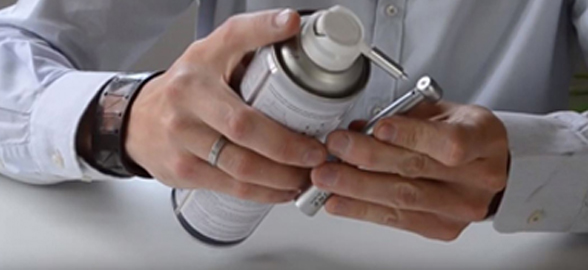In this post we will focus on the specific Zinc Phosphate cement, since it is one of the most used dental cements in dentistry and is the oldest cementing agent of acid-base reaction, high strength and low solubility. To know more about the subject, we recommend that you continue reading about its physical, biological properties, and its handling and retention.
Zinc Phosphate cement
Zinc Phosphate cement is made from/in a pot with powder and another liquid:

This Zinc Phosphate cement is composed of a powder and other liquid can each with its own characteristics.
- The working time is measured from the beginning until the viscosity of the mixture is low enough to flow when compacted and form a thin layer.
- The setting time is the period during which the formation of the matrix has reached a point where the external physical alterations will not cause permanent dimensional changes (from 2.5 to 8 minutes).There are 4 procedures to increase setting. This is measured with a 1mm diameter needle that is inserted with a loading force of 400gr. at a temperature of 37 ° C, and with a relative humidity of 90%. Working time is defined as the time from when the mixing starts until the needle can no longer perform a full circular indentation in the cement.
Because the reaction between powder and liquid is exothermic, the most effective method to control the working and setting time is to regulate the temperature of the mixing tile.Cooling this tile significantly decreases the chemical reaction between the powder and the liquid, delaying the formation of the matrix. The mixture is usually made on a cold tile to counteract its exothermic effect. The mixing time of the ingredients is 1 minute and 30 seconds in amounts of 2mg of liquid and 1 gram of powder. Once the reaction has been done, it must be immediately taken to the work area since, as time passes, the viscosity increases, which is not adequate for the prosthesis to settle.
It is important to make an adequate mix of its ingredients. If more liquid is added, greater fluidity will be achieved, decreasing the pH resulting in a weak, irritating and soluble cement, affecting its mechanical properties.
Physical properties
- Mechanics
- Solubility
- The prosthesis can be disinfected if the underlying cement is subjected to stresses above its strength.
- The high solubility can cause the loss of cement necessary for retention and can form plaque accumulation zones.
- Compressive strength of up to 104 mega pascals.
- Diametral tensile strength of approximately 5.5 MPa.
- It has a modulus of elasticity of approx. 13.7 gigpascales.
- The resistance to compression and traction vary with the P / L ratio, which is why it recommends that the ratio be 1.4 g of powder per 0.5 ml of liquid.
Retention
- It does not cause any reaction with the hard tissues and other surrounding restorative materials, since the adhesion is done by mechanical gear and not by chemical interactions.
Biological properties
- The presence of phosphoric acid causes the acidity to be very high at the moment in which the prosthesis is placed.
- 2 min. After the start of the mixture, the pH of the cement is approx. 2, which increases rapidly but will be 5.5 hours after 24 hours.
Handling
- 5 points for handling. It is not necessary to use measuring devices to achieve the proportions of powder and liquid, because the consistency can vary according to the clinical situation.
- A cold tile should be used
- According to the instructions, the powder should be divided into many portions. A good rule to follow is the spatula of each increment for 15 to 20 sec.
- The prosthesis should be placed immediately before the formation of the matrix occurs.
- The excess cement is only removed once the cement has hardened. It is advisable to apply a layer of varnish or other impermeable coating in the margin of the restoration. This allows a longer ripening time and increases resistance to dissolution in oral fluids.
Advantages of Zinc Phosphate cement
- Easy to manipulate
- Economic.
- The excess material is removed easily.
Disadvantages of Zinc Phosphate cement
- Not aesthetic
- They account for the largest cases of microfiltration.
- Speed with the preparation of the mixture.
Among all the different brands that exist in the market that offer zinc phosphate cement, we recommend the following from our catalog:
If you liked this post, do not miss the next ones about other types of dental cements :)






